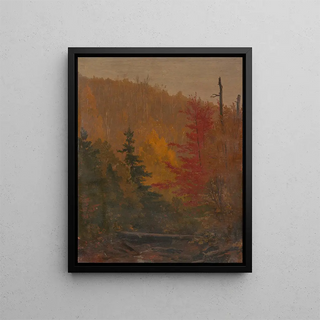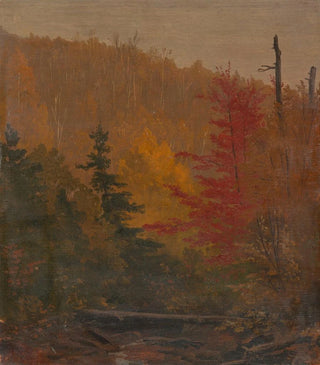Art print | Probably near Katahdin in autumn - Frederic Edwin Church


View from behind

Frame (optional)
Probable near Katahdin in autumn - Frederic Edwin Church – Captivating introduction
In the fascinating world of 19th-century American landscape art, the artwork "Probablement près de Katahdin en automne" by Frederic Edwin Church stands out for its ability to capture the fleeting magic of nature. This canvas, which evokes the majestic landscapes of Maine, transports us to the heart of an autumn scene where vibrant colors blend with golden light, creating an atmosphere that is both serene and vibrant. The composition, rich in detail, invites the viewer to immerse themselves in a sensory experience, where each shade of color seems to vibrate under the gentle breeze. Church, master of light and shadow, manages to evoke a sense of depth and movement, as if the landscape is in constant evolution.
Style and uniqueness of the artwork
Church's work is characterized by a romantic style that transcends mere representation of the landscape. In "Probablement près de Katahdin en automne," it is not just a painting, but a true ode to nature. The artist uses a palette of warm, earthy colors, typical of autumn, to convey the fleeting beauty of this season. The trees with fiery foliage, shimmering reflections on the water, and the sky with gradient hues create a visual harmony that captures attention. The use of light is also essential, with Church skillfully playing with contrasts to bring his landscapes to life. This painting stands out for its striking realism, but also for the way it evokes a deep emotion, that of contemplation and wonder at the grandeur of nature.
The artist and his influence
Frederic Edwin Church, an emblematic figure of the Hudson River School movement, profoundly influenced American landscape art. Raised in an environment that valued nature, Church was able to combine his exceptional talent with a passion for exploring American and South American landscapes. His artistic approach, which blends scientific precision with romantic sensitivity, paved the way for many contemporary artists. Traveling through regions still unexplored, Church succeeded in capturing landscapes of a

Matte finish

View from behind

Frame (optional)
Probable near Katahdin in autumn - Frederic Edwin Church – Captivating introduction
In the fascinating world of 19th-century American landscape art, the artwork "Probablement près de Katahdin en automne" by Frederic Edwin Church stands out for its ability to capture the fleeting magic of nature. This canvas, which evokes the majestic landscapes of Maine, transports us to the heart of an autumn scene where vibrant colors blend with golden light, creating an atmosphere that is both serene and vibrant. The composition, rich in detail, invites the viewer to immerse themselves in a sensory experience, where each shade of color seems to vibrate under the gentle breeze. Church, master of light and shadow, manages to evoke a sense of depth and movement, as if the landscape is in constant evolution.
Style and uniqueness of the artwork
Church's work is characterized by a romantic style that transcends mere representation of the landscape. In "Probablement près de Katahdin en automne," it is not just a painting, but a true ode to nature. The artist uses a palette of warm, earthy colors, typical of autumn, to convey the fleeting beauty of this season. The trees with fiery foliage, shimmering reflections on the water, and the sky with gradient hues create a visual harmony that captures attention. The use of light is also essential, with Church skillfully playing with contrasts to bring his landscapes to life. This painting stands out for its striking realism, but also for the way it evokes a deep emotion, that of contemplation and wonder at the grandeur of nature.
The artist and his influence
Frederic Edwin Church, an emblematic figure of the Hudson River School movement, profoundly influenced American landscape art. Raised in an environment that valued nature, Church was able to combine his exceptional talent with a passion for exploring American and South American landscapes. His artistic approach, which blends scientific precision with romantic sensitivity, paved the way for many contemporary artists. Traveling through regions still unexplored, Church succeeded in capturing landscapes of a






